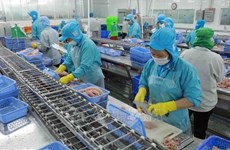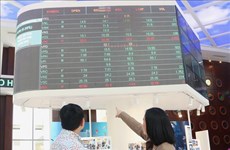Shoe exporters face obstacles
Late last year, the EU decided to increase its anti-duping duties on
Vietnamese leather shoes by 10 percent, which will be in place until the
first
quarter of next year.
Vietnam 's footwear industry earned 1.36 billion USD from exports in the first
four months of this year, a modest increase of 5.7 percent from a year ago.
It is expected that the sector, the fourth largest exporter in the world, will continue to meet difficulties in the coming months.
On average, the industry exports about 350 million USD worth of shoes each month.
The Vietnam Leather and Footwear Association (Lefaso) estimates that total export turnover will be 4.5-5 billion USD by the end of this year.
Major importers include the EU, the US , Japan , Mexico and Canada .
One of the greatest obstacles faced by local shoemakers is that they have to meet the strict trade regulations imposed by the EU, Peru and Turkey .
Late last year, the EU decided to increase its anti-duping duties on Vietnamese leather shoes by 10 percent, which will be in place until the first quarter of next year.
This has a very negative impact on local producers as the EU is the largest importer of Vietnamese footwear, said Nguyen Duc Thuan, Lefaso's chairman.
Last February, Turkey also extended safeguards on three categories of Vietnamese shoe to August 2012.
Under Turkey 's decision, anti-dumping tariffs of 1.7 USD were imposed on Vietnamese plastic and fabric shoes, while the rate for leather products is about 2.5 USD per pair.
Nguyen Thi Tong, Lefaso's general secretary, said: "Although the export revenue to Turkey was not large like those to the EU and American markets, the decision still adversely impacts on Vietnamese makers."
The volume of made-in-Vietnam shoes exported to Turkey had not increased sharply, she added.
According to Lefaso , Vietnam exported about 3 million pairs of shoes to Turkey worth 5 million USD yearly from 2007-09.
Peru has also imposed anti-dumping duties on fabric shoes made in Vietnam .
Thuan added that the sector was dependent on imports of raw materials and accessories that had gone up in price recently. He also said sales were hit by poor designs and poorly trained staff.
To deal with the issue, the association said it would focus on training human resources, reduce costs, invest in research, diversify designs and develop a national trademark.
It called on the Government to encourage foreign companies to invest in building a national market for trading raw materials and accessories./.
It is expected that the sector, the fourth largest exporter in the world, will continue to meet difficulties in the coming months.
On average, the industry exports about 350 million USD worth of shoes each month.
The Vietnam Leather and Footwear Association (Lefaso) estimates that total export turnover will be 4.5-5 billion USD by the end of this year.
Major importers include the EU, the US , Japan , Mexico and Canada .
One of the greatest obstacles faced by local shoemakers is that they have to meet the strict trade regulations imposed by the EU, Peru and Turkey .
Late last year, the EU decided to increase its anti-duping duties on Vietnamese leather shoes by 10 percent, which will be in place until the first quarter of next year.
This has a very negative impact on local producers as the EU is the largest importer of Vietnamese footwear, said Nguyen Duc Thuan, Lefaso's chairman.
Last February, Turkey also extended safeguards on three categories of Vietnamese shoe to August 2012.
Under Turkey 's decision, anti-dumping tariffs of 1.7 USD were imposed on Vietnamese plastic and fabric shoes, while the rate for leather products is about 2.5 USD per pair.
Nguyen Thi Tong, Lefaso's general secretary, said: "Although the export revenue to Turkey was not large like those to the EU and American markets, the decision still adversely impacts on Vietnamese makers."
The volume of made-in-Vietnam shoes exported to Turkey had not increased sharply, she added.
According to Lefaso , Vietnam exported about 3 million pairs of shoes to Turkey worth 5 million USD yearly from 2007-09.
Peru has also imposed anti-dumping duties on fabric shoes made in Vietnam .
Thuan added that the sector was dependent on imports of raw materials and accessories that had gone up in price recently. He also said sales were hit by poor designs and poorly trained staff.
To deal with the issue, the association said it would focus on training human resources, reduce costs, invest in research, diversify designs and develop a national trademark.
It called on the Government to encourage foreign companies to invest in building a national market for trading raw materials and accessories./.











